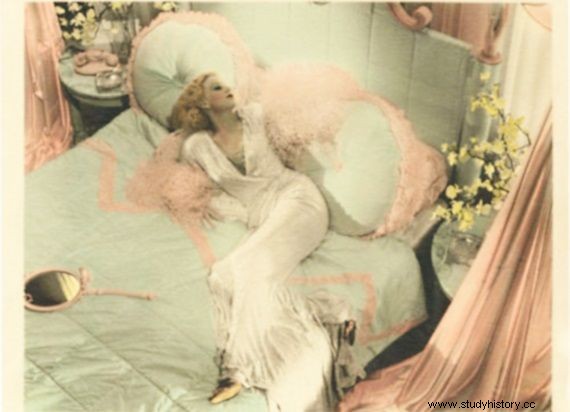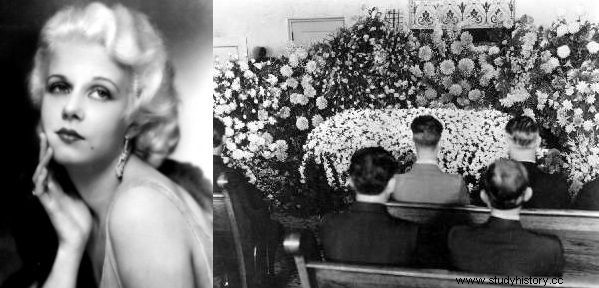Before Marilyn Monroe, there was Jean Harlow. It was she, not MM, who brutally threw brunettes off the Hollywood pedestal. Before she died at the age of only 26, she had married three times, starred in over twenty productions and caused countless scandals. Her platinum blonde killed her.
Jean Harlow was born on March 3, 1911 in Kansas City into a wealthy family as Harlean Harlow Carpenter. By the time she was 20, she had become a phenomenon Hollywood had never known before.
Dazzling the screen with ecstatic femininity, wild sensuality and platinum hair that no other actress could boast of, it attracted crowds of viewers to the cinemas to watch the "blonde goddess". She was said not to accept underwear but loves the cool touch of satin on the skin. Her inaccessible beauty was emphasized by the white dresses she liked to wear, as well as diamonds worn for any more or less formal occasion.
She was a real blonde vamp when Norma Jeane Mortenson (later known as Marylin Monroe) was still in kindergarten. It was an unattainable platinum shade of hair that made Jean famous , becoming her trademark for the rest of her career - and life.
Killer (literally!) blonde
What was the secret of Jean Harlow's hair color? Of course, both herself and her film studio claimed that an unusual, light shade is the natural color of the star's hair. Susan Ohmer, co-author of Glamor in a Golden Age:Movie Stars of the 1930s, reports that the term "platinum blonde" was first used in relation to Jean in October 1930.
This new epithet, which has permanently entered the barber's language of color, was coined on the occasion of the announcement of the premiere of the new film Harlow. Not a word was mentioned about the other actors. In 1931, newspapers reported that Hollywood's ideal of beauty had changed, and the dark-haired, stylish beauty was replaced by a "sweet, blonde-haired creature" using completely different methods of seduction. Humor, lively temper and skimpy clothes.

Beautiful, seductive femme fatale. A colored frame from the movie "Dinner at Eight" (1933).
Jean was a perfect fit for this new canon of beauty, even if everything - from the platinum storm of curls to predatory sexuality - was largely a picture created for the screen. And while sexiness could only harm her through the jealous glances of women whose husbands longed to follow Jean with their eyes, the famous blonde hair probably actually drove the star into her grave.
In her early youth, Harlow underwent severe scarlet fever, which resulted in kidney problems. By the time she died on June 7, 1937, her kidneys completely failed to obey.
The official cause of death was uremia, from which Jean had been suffering from symptoms for several months. However, its condition must have been contributed to by many years of bleaching the hair with the use of shivering methods.
You can learn how to make your own cosmetics without harmful ingredients in the book "Beauty without preservatives":
Deadly Potion
Taylor Orci, a journalist for The Atlantic magazine, believes that to achieve the shade that made Jean famous, the stylist had to apply a special mixture to the star's head once a week. It included an oxidizer, ammonia, bleach from a manufacturer popular in the United States, and soap flakes.
This crazy mix of chemicals put a strain on her weakened kidneys that they couldn't continue to work. While there is no direct evidence to support this theory, it is still circulating today. This is an integral part of the Jean Harlow myth - the platinum femme fatale who was killed by what helped her become such incredible fame.
According to A. H. Petersen, author of Sex, Deviance, and Drama from the Golden Age of American Cinema, Jean herself once stated that if it weren't for her hair, Hollywood would never have known about her existence.

Jean Harlow and John Barrymore on the set of Eighth Dinner (1933).
Such an explanation of the mystery of premature death fits much better with her image than the more prosaic version given by biographers and relatives - alcohol problems.
How do I say goodbye to the icon?
The death of Jean Harlow shocked all of Hollywood. The co-workers could not pity her, they spoke about the star in superlatives.
Clark Gable did not want to comment on her death because of such great mourning, director W.S. Van Dyke called her "a great actress and an even greater friend", Gary Cooper - "a beautiful and elegant professional".
Louis B. Mayer, in turn, said that he had lost his friend and "the world had lost its ray of sunshine", and Barbara Stanwyck in turn said that it was thanks to people like Jean that she enjoyed acting in movies.
William Powell, to whom she was engaged at the time, had a nervous breakdown. She had a wonderful funeral that the newspapers wrote about for a long time. She was placed in the coffin in the white dress she wore in the movie "Romantic Trap", with a single gardenia flower in her hands, of course in her beloved white color.

When she died unexpectedly, a crowd of the brightest Hollywood stars led her on her last journey, and her coffin was drowned in flowers ...
One obituary said that Jean Harlow's life resembled continuously moving film frames - some depicting images full of happiness, others tragic. Though her career was very short-lived, she partnered with such stars of the 1930s as Clark Gable, Spencer Tracy, Robert Taylor and William Powell.
She collaborated with the greatest film studios of the era, playing the roles of modern, liberated and open-minded women. She became the first actress to appear on the cover of Life in 1937. The strength of her image seems to lie in the combination of her platinum blonde, voluptuous body and charismatic personality.
The bold sexuality she portrayed on the screen, the complicated life outside of it, and the untimely death shrouded in mystery made Jean Harlow a Hollywood legend.
You can learn how to make your own cosmetics without harmful ingredients in the book "Beauty without preservatives":
Editor:Aleksandra Zaprutko-Janicka; Photo edition:Aleksandra Zaprutko-Janicka
